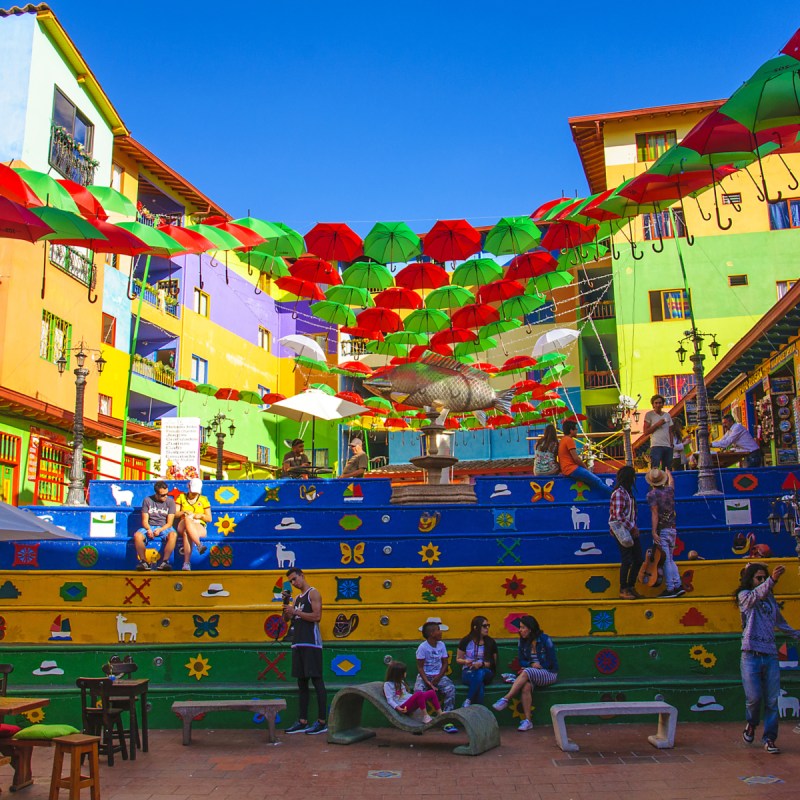
Latin America is practically one big pop of color, from its lush green forests to the beautiful coastline, or, in the case of Peru, those utterly stunning Rainbow Mountains. Add the indigenous weaving, the music, and the vibrant atmosphere, and it is not surprising that the decision of which colorful cities to pick for this edition of “Most Colorful Cities in…” was difficult.
Videos by TravelAwaits
So, as always, I went with those I know, or, if I haven’t quite made it there yet, at least places I have on my radar and have researched extensively. A couple of cities, Valparaiso and Buenos Aires have already been awarded a place in my Most Colorful Cities in the World selection, but that is because they are simply the best when it comes to a pop of metropolitan color.
Enjoy planning your next colorful getaway to Latin America!

1. Valparaiso, Chile
Before I ever visited Valparaiso, I knew I would love it. A once-thriving port city that had persevered through economic decline and hardships under political dictatorship, through color and street art, always offers something special. In Valparaiso, street art was once encouraged by Nobel prize-winning poet Pablo Neruda, then went underground, only to emerge again, and is now loved and thriving. Walking through the steep streets, with every corner a picture, and even humble staircases turned into works of art, you can spend hours, in fact, days discovering new pieces of art. It is one of the most colorful places, and one of my favorite art-filled cities in the world.
Pro Tip: The only way to try and see most of the art on display is by guided walking tour, and even then, you have the constant feeling that you should be looking around the next corner. So, I suggest you start off with one guided tour to get your bearings, and then go back and add to it with a self-guided walking tour experience later.

2. Santa Marta Favela, Rio De Janeiro, Brazil
Rio de Janeiro conjures up images of glamorous hotels, stunning beaches, and happy people in bikinis frolicking on the same. But the brightly colored favelas are as much part of Rio as Christ the Redeemer or Sugarloaf Mountain. I’m not a fan of so-called slum tourism myself, and there are arguments for and against it. That said, visitors to these areas bring money to those who need it most in the city. Much like in other Latin American cities where street art and literally painting the town have brought together poorer communities, the favelas in Rio have undergone art-centric revivals, and it is worthwhile taking a closer look at these vibrant communities clinging onto the sides of the city’s many steep mountains.
Pro Tip: To state the obvious, don’t try and attempt to go into the favelas without a guide, and even when with a guide, don’t carry your best purse or watch. But do go with a local and spend some money in the neighborhood shops.

3. La Boca, Buenos Aires, Argentina
Buenos Aires is one of my favorite cities in South America. It is like a Paris that has frayed around the edges, but with the faded grandeur and the vibrancy of the city still very much present. Full of music, dance, art, and culture, Buenos Aires has many distinct neighborhoods, and La Boca is the colorful one. La Boca, the mouth, was once the port area of Buenos Aires, and today is best known for its street markets, street art, and painted surroundings. Even the cobbles on the streets are painted. Touristy, with many posing tango-dancing couples displaying their skill in front of popular bars, yes. But fun despite the hype? For sure. Especially for photographers and Instagram enthusiasts, this colorful neighborhood is difficult to beat.
Pro Tip: Caminito is a lane, literally meaning small path, within La Boca, and is even more colorful than the rest. Here, you’ll find a fabulous street market full of art and arts and crafts. The market is open daily, but the most stalls are out on weekends.

4. Guatapé, Colombia
This is, reportedly, the most colorful city or town in Colombia — and maybe even in South America. Colombia itself is full of worthwhile sights, but a stop in Guatapé is a must if you like color. Not only are private residences as well as public buildings painted in all the colors of the rainbow and then some, but they also have special frescos on each house called zocalos. Some of the frescoes are abstract patterns while others depict more recognizable shapes such as chickens, flowers, and birds. Each and every house is worth taking a picture of, and having entire streets filled with them is just ridiculously joyous. Just exactly how and why this tradition of the zocalos has started nobody seems to know, but they are now a fixture and a must-see when in Colombia.
Pro Tip: The surroundings of Guatapé are also worth exploring, so, if coming from Medellin, which is roughly two hours by bus, why not stay the night before heading back? There are also organized tours if you are shy of taking local transport.

5. Batman Alley, São Paulo, Brazil
Wherever I go, I search out areas that are known for their street art. Sometimes those can be slightly dodgy neighborhoods, visited with care, but other times, as in the case of Batman Alley, they are dedicated areas where artists are allowed and encouraged to let loose. This alleyway would normally have been a nondescript back lane, boring and bland, but now, adorned with ever-changing murals, it is an outdoor art gallery in a lovely neighborhood that is colorful and filled with small boutiques and cafes, making you linger a little longer.
Pro Tip: São Paulo is not only full of amazing museums and art galleries but also has some of the largest commissioned murals by world-renowned street artists in the world. As you drive through the city, look out for underpasses along the motorways and up at the towering apartment blocks in the city center. Most spaces are adorned by art.

6. Pelourinho, Salvador, Brazil
Pelourinho means whipping post in Portuguese, and this neighborhood of Salvador, the upper, old part, was where the slave auctions took place. Ironically, like in most Central, Caribbean, and South American cities, it is the colonial buildings we find so beautiful, and they are, but the history behind them is disturbing. That said, it is history, and should not be ignored, and, as a UNESCO World Heritage Site, this very colorful part of the city is being cherished and preserved.
Pro Tip: Pelourinho is on a hill overlooking Salvador, and the climb can take a toll on your knees. Instead, take the lift, Elevador Lacerda, to the top. It’s a sight in itself, with fabulous views from the top.

7. Guayaquil, Ecuador
Apart from being a colorful city, Guayaquil also has Ecuador’s second busiest airport and is the transit hub to the Galapagos Islands, so, if you are en route, book a brief stopover and enjoy the city. While it is an ever-growing modern city, there is an old colonial part that dates to 1538. The old town, Las Peñas, is located at the end of the Malecón 2000, the bustling beach promenade, on a hill overlooking the port. It is a real pop of color. To best appreciate it, climb the 444 Steps of Cerro Santa Ana, a wide, comfortable staircase hemmed by beautiful buildings and lined with palm trees and pieces of art. And even if 444 steps sound a lot, it is a comfortable climb.
Pro Tip: Don’t miss Numa Pompilio Llona, a cobbled street at the bottom of the hill, which is famous for its old wooden buildings.

8. Granada, Nicaragua
Granada in Nicaragua is a hotchpotch of colonial buildings, some dating to 1524, crowded markets, a great selection of cafes and restaurants, and the sunshine-yellow Cathedral Iglesia Guadalupe. The entire old center is full of single-story residences, each brighter than the next, but one of the best streets to linger for a while is La Calzada, also known as Gringo Street. Touristy, yes, but full of cafes and restaurants, color, and street musicians. Perfect for a lazy afternoon.
Pro Tip: Granada lies on the shores of Lake Nicaragua, the only freshwater lake that contains oceanic, that is, saltwater species of fish, which are believed to have become trapped there after the lake was formed by a volcanic eruption.

9. Panama City, Panama
Panama City is one of those cities where super-modern meets old and charming. The Casco Viejo is one of my favorite places in Latin America because of its gorgeous — yes, colonial — architecture that is painted in vibrant colors. The old town is filled with lovely boutiques (Panama hat, anybody?), arty markets, superb top-rated restaurants, atmospheric cafes, and many picturesque spots. Add to that the carnival and the truly rainbow-colored Frank Gehry-designed Bio Museum, and you have a superbly colorful mix which to enjoy within easy reach of the States.
Pro Tip: Spend your first night on the rooftop bar Tantalo, which I include in my picks for The World’s 9 Best Champagne Bars To Enjoy A Sip. The views are incredible.

